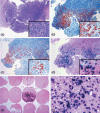Changing patterns in the frequency of Hodgkin lymphoma subtypes and Epstein-Barr virus association in Taiwan
- PMID: 18201268
- PMCID: PMC11158065
- DOI: 10.1111/j.1349-7006.2007.00667.x
Changing patterns in the frequency of Hodgkin lymphoma subtypes and Epstein-Barr virus association in Taiwan
Abstract
Epstein-Barr virus (EBV) infection is a risk factor for Hodgkin lymphoma (HL). To test whether the frequency of HL subtypes and their association with EBV has shifted with rising socioeconomic status in Taiwan, we compared the pathological features and EBV status, detected by in situ hybridization, of HL diagnosed between 1996 and 2007 (99 cases) and 1982 and 1995 (74 cases). The male-to-female ratio was 121:52 (2.3:1) and the mean age at presentation was 41.5 years. The overall EBV positivity rate was 50% (86/173 cases). Comparing the distribution of HL cases diagnosed at two different time periods, we found an increased frequency of the nodular sclerosis (NS) subtype (53 vs 68%, P = 0.045), a decreased frequency of the mixed cellularity subtype (35 vs 13%, P < 0.001), a reduced male-to-female ratio (2.9:1 compared to 1.4:1) and mean age (42.4 vs 36.6 years) in the NS subtype, and a significant decrease in EBV positivity rates among the NS and lymphocyte-depletion subtypes (61 vs 39%, P = 0.03). These data indicate shifts in the frequency of histological subtype and EBV association for HL in Taiwan over the last decade, with a trend closer to that seen in Western countries and Japan.
Figures

Similar articles
-
Hodgkin lymphoma in Pakistan: an analysis of subtypes and their correlation with Epstein Barr virus.Asian Pac J Cancer Prev. 2011;12(6):1385-8. Asian Pac J Cancer Prev. 2011. PMID: 22126469
-
Changing patterns in the Epstein-Barr virus (EBV)and Hodgkin lymphoma association in Tunisia.Ann Hematol. 2016 Sep;95(9):1537-43. doi: 10.1007/s00277-016-2737-4. Epub 2016 Jul 5. Ann Hematol. 2016. PMID: 27378019
-
Epstein-Barr virus is associated with all histological subtypes of Hodgkin lymphoma in Vietnamese children with special emphasis on the entity of lymphocyte predominance subtype.Hum Pathol. 2005 Jul;36(7):747-55. doi: 10.1016/j.humpath.2005.05.003. Hum Pathol. 2005. PMID: 16084943
-
Changing trend of Epstein-Barr virus association in Hodgkin lymphoma in the Republic of Korea.Ann Hematol. 2013 Dec;92(12):1653-60. doi: 10.1007/s00277-013-1837-7. Epub 2013 Jul 6. Ann Hematol. 2013. PMID: 23832190 Review.
-
Epstein-Barr virus as a marker of survival after Hodgkin's lymphoma: a population-based study.J Clin Oncol. 2005 Oct 20;23(30):7604-13. doi: 10.1200/JCO.2005.02.6310. Epub 2005 Sep 26. J Clin Oncol. 2005. PMID: 16186595 Review.
Cited by
-
Distribution and clinical features of lymphomas involving skin in Taiwan.Kaohsiung J Med Sci. 2023 May;39(5):522-532. doi: 10.1002/kjm2.12659. Epub 2023 Feb 16. Kaohsiung J Med Sci. 2023. PMID: 36794661 Free PMC article.
-
Malignant lymphomas (ML) and HIV infection in Tanzania.J Exp Clin Cancer Res. 2008 Jun 10;27(1):9. doi: 10.1186/1756-9966-27-9. J Exp Clin Cancer Res. 2008. PMID: 18577266 Free PMC article.
-
Evidence for distinct mechanisms of immune suppression in EBV-positive and EBV-negative Hodgkin lymphoma.J Clin Exp Hematop. 2023;63(4):230-239. doi: 10.3960/jslrt.23037. J Clin Exp Hematop. 2023. PMID: 38148013 Free PMC article.
-
Epstein-Barr virus latent membrane protein-1 upregulates autophagy and promotes viability in Hodgkin lymphoma: Implications for targeted therapy.Cancer Sci. 2021 Apr;112(4):1589-1602. doi: 10.1111/cas.14833. Epub 2021 Feb 16. Cancer Sci. 2021. PMID: 33525055 Free PMC article.
-
Epstein-Barr virus and Hodgkin's lymphoma in Cairo, Egypt.J Hematop. 2010 Jun;3(1):11-8. doi: 10.1007/s12308-010-0059-3. Epub 2010 May 28. J Hematop. 2010. PMID: 21625283 Free PMC article.
References
-
- Lehane DE. A seroepidemiologic study of infectious mononucleosis. The development of EB virus antibody in a military population. JAMA 1970; 212: 2240–2. - PubMed
-
- Gutensohn N, Cole P. Childhood social environment and Hodgkin's disease. N Engl J Med 1981; 304: 135–40. - PubMed
-
- Hjalgrim H, Askling J, Rostgaard K et al . Characteristics of Hodgkin's lymphoma after infectious mononucleosis. N Engl J Med 2003; 349: 1324–32. - PubMed
-
- Hesse J, Ibsen KK, Krabbe S, Uldall P. Prevalence of antibodies to Epstein–Barr virus (EBV) in childhood and adolescence in Denmark. Scand J Infect Dis 1983; 15: 335–8. - PubMed
-
- Sumaya CV, Henle W, Henle G, Smith MH, LeBlanc D. Seroepidemiologic study of Epstein–Barr virus infections in a rural community. J Infect Dis 1975; 131: 403–8. - PubMed
Publication types
MeSH terms
LinkOut - more resources
Full Text Sources
Medical
Miscellaneous

